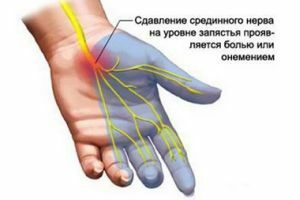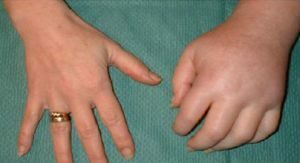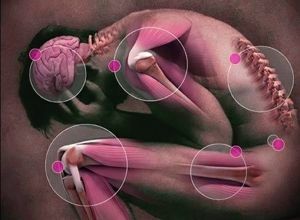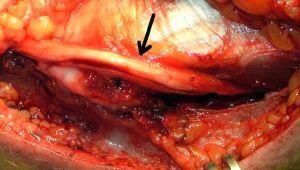 Syndrome Zudeka - a kind of neuropathic pain syndrome, a pathological condition caused by damage to soft tissues, nerves, joints or bones.
Syndrome Zudeka - a kind of neuropathic pain syndrome, a pathological condition caused by damage to soft tissues, nerves, joints or bones.
The disease is accompanied by osteoporosis( bone atrophy), limitations of mobility in the joint, blood flow disorders and associated trophic consequences.
For the first time the disease was presented and characterized by the German surgeon P. Zudek in 1900.
He noted that on radiographic images with some inflammatory processes in the bones and joints with subsequent atrophy, there is transparency of the bone pattern, calling this phenomenon acute trophoneurotic atrophy.
Causes of the disease
The most common cause of the disease is complications after trauma or fracture of the limb, improper treatment or immobilization of the hand( ensuring complete rest), with damage to the nerves or sympathetic nerve nodes.
Poorly applied dressings, painful manipulations, admission of edema, immobility of the joint - all this can gradually lead to the development of Zudeck's syndrome.
Vegeto-vascular disorders, hormonal disorders and oncological diseases have a definite place in the formation of the borderline state. Women suffer more often after 40 years, although there are frequent cases of the syndrome in men.
The cause of the appearance of the pathological condition is also called fractures:
- radius - about 62%;
- of the lower limbs - 30%;
- of the humerus - 8%.
Elderly and middle-aged people often suffer from upper limb syndrome, and children - lower.
Clinical picture of
Any trauma is accompanied by disorders of the vasomotor mechanism and the autonomic nervous system. 
With proper treatment, all negative manifestations gradually pass, and the healing process begins.
Otherwise, the battle intensifies with the slightest movement or touch.
There are three clinical stages of the Syndrome Syndrome, each of which has its own symptoms:
- I - acute form .It is characterized by intense, burning pain, the edema of the damaged limb develops. Pain syndrome is not removed by traditional analgesics. The temperature in the place of injury rises, the joints are stiff. Duration - up to 6 months;
- II is the dystrophic stage of .The temperature gradually decreases, the swelling also decreases slightly. The pain is permanent, but less intense. Tendons thicken, begins to develop osteoporosis.
- III - atrophic stage of .The skin acquires a cyanotic color( marble), it becomes cold, it becomes very thin. Dystrophy of soft tissues and osteoporosis lead to tissue atrophy. Pain in this period is practically absent. The lesion gradually covers the bone system, which is manifested in the hardening of the joints, fibrosing of the slender apparatus of the tendons, bone rarity. Duration - from 6 to 12 months after injury.
Methods of therapy
Disease at the I and II stages of development is easy to stop and the patient can go on the amendment quickly enough.
III degree is chronic and characterized by tissue atrophy, which complicates the process of recovery.
With proper treatment, the mobility of the joint is only partially restored.
Treatment of the Syndrome of Zudek in the acute stage includes:
- limb immobilization for 12-14 days according to the doctor's indications;
- applying cold to the affected area;
- acupuncture in combination with ultrasound of the reflex zones of the limb;
- magnetotherapy;
- interference therapy.
 Medication is usually conservative. The specialist prescribes vasodilator and analgesic drugs, B vitamins, Ca antagonists, muscle relaxants, α - adrenoblockers.
Medication is usually conservative. The specialist prescribes vasodilator and analgesic drugs, B vitamins, Ca antagonists, muscle relaxants, α - adrenoblockers.
In more serious cases, professional help from a psychologist may be required. According to the indications, a short course of neuroleptics and antidepressants, corticosteroids is carried out.
If pathogenetic treatment does not work, the intensity of the pain syndrome persists, the patient is offered a surgical intervention. The operation implies a sympathetic blockade: the introduction of intravenous regional, procaine drugs into the nerve, as well as infiltration anesthesia.
In advanced cases, joint arthrodesis is shown, slow stretching of the affected area, osteotomy of the distal metaepiphysis of the radius and other operations.
Therapy requires a long and comprehensive approach. Terms of treatment depend on the stage and complexity of the disease, the age of the patient, the effectiveness of the treatment measures, and range from 6 months to a year.
Forecast
At the first and second stages of the disease, in the first weeks from the development of the complication, the prognosis is quite favorable.
III stage is characterized by a more complex prediction, with the progression of the disease it is often unfavorable, since irreversible disturbances have begun in the tissues.
Despite the wide arsenal of treatment measures, Zudek's syndrome remains a complex disease with an unclear pathogenetic mechanism, which complicates treatment.
Complete recovery is possible with an early referral to specialists and comes, as a rule, 6 months after the start of therapy. In some patients, slight movement restrictions, impaired limb working functions can persist for long enough.
Preventative measures
There are no specific preventive measures for algoneurodrophy. Experts advise to take a closer look at their health, do not delay the visit to the doctor and at the first signs of a malaise seek help.
During rehabilitation it is necessary to be cautious about intensive thermal procedures, to avoid rough  massage activities. Allowed exercise therapy, sanatorium treatment with radon baths, gravity therapy.
massage activities. Allowed exercise therapy, sanatorium treatment with radon baths, gravity therapy.
The development of a pathological syndrome can be interrupted at any stage, but the frequent outcome of the disease is fibrotic ankylosis in stable decompensation, which leads in most cases to disruption of normal functioning and to disability.
Complete recovery comes only with timely access to a specialist and observance of all medical measures aimed at bone regeneration, removal of pain syndrome and prevention of progression of atrophy.



